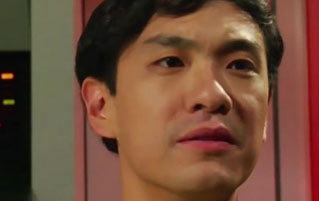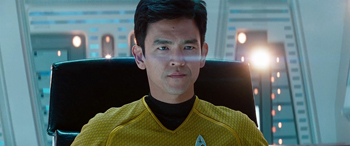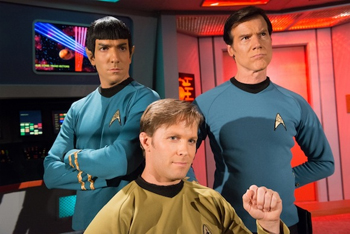I Played Sulu For Years (In A Series You've Never Seen)

The closest most of us will ever get to being our favorite fictional character is dressing up for cons. Maybe some nerd-based sexual role play, if we're really lucky. But not John Lim. From 2006 to 2009, he was Sulu. And not in his own sad YouTube videos, either -- he was part of the cast of Star Trek: New Voyages (also known as Star Trek: Phase II), an award-winning fan-created web series noted for its remarkable 12-year run and professional quality. It doesn't get much bigger -- well, unless you get paid for it. So when we wondered what it would be like for your nerdiest dreams to come true, we knew who to ask.
With A Little Luck And Determination, You Can Make Your Nerd Dreams A Reality
"It started around 2003-2004," John says. "I had just gotten dumped by a girl I was dating, so I had a lot more time on my hands." Naturally, he followed in the footsteps of lonely nerds everywhere and booked a one-way ticket to the internet. "One day, I stumbled onto these fan-made Star Wars fan films, and they were mesmerizing, in that some were really professional-looking, and others really bad -- and intentionally so. Being that I grew up loving both Wars and Trek, I decided to see if there were any for Star Trek. At the time, there were only a handful. The most professional-looking one was New Voyages. Whereas many had CGI and green screen, these guys had recreated the sets and the costumes, and pretty faithfully, too."
"I watched the pilot episode, 'Come What May,'" John continues, "and noticed that they didn't have a Sulu in it." You can tell these guys were pros, because they covered this glaring absence the same way Hollywood does: "They had a throwaway line that he was away for command training or something."
"He stuck in the bathroom again?"
"Yeah, Bones called it the worst case of space diarrhea he's ever seen."
John already had some acting experience under his spandex Starfleet belt area, and had started getting back into it. He recognized an opportunity when it beamed into his lap, and decided to offer himself up to the Nerd Gods.
"It wasn't clear at the time who was in charge, or how to contact them. They had a discussion forum, and I saw that one producer/director (Jack Marshall) of the episode lived not far from where I was, so I sent him an email, but didn't hear back. I then decided to see if there was someone else I could contact, and found some posts from the guy who created the sets, costumes (and also played Kirk), James Cawley ... I didn't hear back for a couple of weeks (it turned out Jack and James were in the middle of filming the second episode, 'In Harm's Way'), but finally I heard back from James, and then he invited me up to visit the sets, which were in upstate NY. I figured, 'OK, we must be talking about somewhere like Westchester, right outside of the city, since it looked like a pretty professional production.' No, the sets and production were in a tiny building in Ft. Ticonderoga, NY, outside of Lake George."
It was, in fact, a former used car dealership:
"Just think how many excited people saw their dreams turn into an endless sinkhole of money at this dealership."
After "a tour of the sets and an informal audition," John was welcomed to the team, but "there was a bit of confusion, because James apparently didn't tell Jack until later, and announced my casting before anyone else knew about it." Ominous foreshadowing, then cut to commercial break ...
It's Not Amateur, It's Not Hollywood -- It's Somewhere In Between
John describes the production as having an "identity crisis," because we're talking about an abandoned dollar store filled with handmade sets built by volunteers and starring an Elvis impersonator:

Dollar store? Wasn't it just a used car dealership? Well, at some point they got these fancy new digs:

"The realtor assured me that the raccoons are much friendlier here."
And eventually, they found themselves some real Hollywood writers, designers, actors, and producers -- some of whom worked on the original Star Trek series.
"When New Voyages started, they had several people behind the scenes, like Doug Drexler (VFX guru who worked on TNG and Battlestar Galactica), helping out with the production," John says. "By the time I joined, Walter Koenig had been cast as Chekov, an original cast member reprising his role for the first time since Star Trek: Generations in 1994. This was a pretty huge deal ... Now when we got to 'World Enough And Time,' the episode with George , that's when the stakes were raised even higher. Hollywood producer Marc Zicree (Babylon 5, TNG, Sliders), and Michael Reeves got involved."
We're talking Emmy and Oscar winners working out of a dollar store alongside fans with no experience. "But the thing is, as much as there are aspects of a real film production, there's also the amateur side to it, which includes a lot of chaos, lost time, in-fighting, drama, you name it."
So ... like a real film production, then.
For example, bats.
Actual bats.
"We had a smattering of flies, spiders, and bats inside that set," John says. "Oh, and there was no cell reception, as in zero. Only one guy, a fan volunteer who was acting as set security, had a phone that would get any kind of signal, so in order to make calls off the set, we had to borrow his."
But that doesn't mean they didn't try to keep things professional. "For 'To Serve All My Days', there was a security team (i.e. a bunch of volunteers), and the head of security (someone who worked in security for a living) actually made badges for each cast and crew member to enter in and out of the set. There was even a small machine to press the badges and laminate them with our photos."
That sounds normal enough, until you remember, as John points out, "we were filming in the middle of nowhere and there weren't really any passersby to invade the sets."
One day, Oscar-winning makeup artist Kevin Haney lost his badge, "so in a half-joke / half-'up yours,' he drew a replacement badge out of Magic Marker, complete with artist self-portrait. He would joke about flying back to LA if they turned him away at the door. I'm pretty sure Kevin's self-made badge would go for a lot on eBay."
Eventually, this weird diorama of a Hollywood production started causing some tension among the cast and crew.
"Most of the actors were volunteers, meaning they were there to have fun or put something cool on their reels, etc.," John says. "Andy was also a TV actor and part of the guild, so he had to get paid for his work ... I remember Andy calling me up one day to tell me himself that he was getting paid, we had become friends and he wanted to be transparent, because he knew a lot of us weren't paid for our work. I told him it was all good, and that if I were in his position I would do the same. However, I know it ruffled some feathers."
Eventually, "some of the behind-the-scenes people from the earlier episodes ended up sidelined in favor of people who had more experience," which was painful even for the survivors, because they knew how hard the volunteers worked. John singles out sound technician Ralph Miller. "Now, outside of doing sound for a few indies, it's not his main profession (he paints mailboxes for a living)," he says. "And yet he worked his tail off to get the sound right and edit out the train, outside noise, etc."
"At one point, one of the cinematographers from the first episode sighed and lamented that this was no longer New Voyages, but something completely different. And it was."
It Has All The Backstage Shenanigans Of A Hollywood Drama
Eventually, "Jack and several of the people who worked on the first two episodes wanted to take their experience and develop a wholly original show. James was interested in playing more Star Trek. Jack at one point thought about leaving -- until they got Walter Koenig to star in the next episode, 'To Serve All My Days,' with a script written by original series writer DC Fontana."
The tension between the two came to a head during production of that episode. "Because this was a sequel and character piece, Jack wanted to give it an eerie feel, a la Twilight Zone," John continues. "Jack also wanted to do all of the bridge sparks and explosions using CG instead of actual explosions ... Jack and James butted heads over this for several weeks."
"WHY ARE YOU FIGHTING SO HARD AGAINST BLOWING STUFF UP FOR REAL?!"
Their spat eventually culminated in a bizarre series of passive-aggressive emails to the entire team. "At one point, cast and crew were getting cc'd on emails between the two about who had the footage, whose deadline was the official one, etc." John says. "It was really like watching a ping pong match, because ... most of us just stay silent and out of the crossfire. Eventually, there were two emails: One with Jack departing, and James announcing Jack's departure."
It's not clear whether Jack was fired or resigned (it depends "on who you ask"), but either way, Jack left and "James finished the Walter episode with another director."
There's a bizarre epilogue here. As a result of this fight and what we'll politely call Cawley's dedication, there are tons of different cuts of that episode floating around, from Cawley's "official" version to Marshall's "director's cut" to a bizarre "alternate ending" version that changed Chekov's death (written explicitly for Koenig, "who wanted to put a period on the role of Chekov") to a drunken dream.
"Let's just say 'To Serve All My Days' is the fan film equivalent of Blade Runner or Superman II, with several versions, cuts, directors, and a lot of behind-the-scenes drama."
Being A Fan Property Has Upsides And Downsides
Being a fan production of an existing property, especially with a working relationship with the original artists, has its upsides. For example, many episodes of New Voyages were made from unproduced scripts written for the original shows, including one that was rejected for its themes of homosexuality (and AIDS), and another that brought George Takei to the show. They could explore stories that couldn't be explored before, and won awards in the process.
"Michael had a story that was supposed to be an episode of Star Trek Phase II, which was the revival show that NBC was toying around with in the 1970s, before they eventually ditched the idea to do The Motion Picture," John says. "The episode was supposed to be a flash-forward/back episode about Sulu getting stuck in some other dimension, growing old with a wife and child. He's beamed back aboard the Enterprise, where only minutes have passed for them, but several decades have passed for him. Beautiful script, beautiful episode ... The episode was actually nominated for a Hugo and Nebula Award, and won a TV Guide award for best internet sci-fi film, beating out a web episode of Battlestar Galactica (an official episode)."
Sadly, they had to scrap plans for unproduced scripts that were nevertheless bought by CBS. They were more or less at the mercy of the copyright holders, the biggest caveat being that they weren't allowed to make any money.
"Apparently, when they released the pilot, it caught the attention of some people at CBS in their legal department," John says. "As I understand it, it landed on Rick Berman's desk (exec. producer and showrunner of Star Trek: TNG, DS9, Enterprise) at the time. Apparently, he saw it and some of the recreations were so good (sets, costumes) that they weren't sure if scenes had been lifted from the original series."
"Jack, James, and CBS-Paramount legal had a few phone conversations, and there was a 'gentleman's agreement.' Basically, the studio would look the other way so long as 1) no original series footage was being used and 2) no money was being made from the project. There was no written agreement, and the terms were kinda fuzzy. I think both parties just wanted to keep it very informal."
This led to some creative financing decisions. "I don't know all the details, but I know that James financed a great deal from his Elvis gig. He has said so to the press on numerous occasions, and so it's out there. But I also know that as the series grew, and had guest stars like Walter and George, that the costs grew, too. As I understand it, the financing came from various sources -- mostly friends of the production, and I think Marc had some partners who also infused capital into the George episode (the most expensive one to date)."
But as the fan films got more expensive to produce, they started turning to crowdfunding, at which point CBS could no longer play the "If we can't see it, it doesn't exist" game. "This all came to a head when a project called Axanar raised over $1 million," John says. "They produced a very slick trailer that looked very much like a modern studio film. That's when CBS-Paramount filed its lawsuit, bringing what was a blurry coexistence into copyright litigation nightmare." Eventually, the studio "institute guidelines on what Star Trek fan films can and can't do. The restrictions are heavy, and pretty much prevent anyone from doing what New Voyages did, which is create a series that's a continuation of a prior series. So this marks the end of an era of sorts."
It Opens Doors -- Kind Of
Based on his work in New Voyages, John was nearly cast as Sulu in the J.J. Abrams movies. George Takei even publicly endorsed him.
"I got to know George and he encouraged me," John says. You'd think that's the kind of name that gets you right in the door, but John still had to sneak through it.
"I talked my way past the security guard at Bad Robot's office location (this was before J.J. moved to Paramount) and was able to put my headshot, reel, and press clippings right on April Webster's (J.J.'s casting director) chair," he says. "Next thing I know, I get a call from April's assistant to come in for a private audition. The whole thing was crazy. I had to go to Paramount, sign a nondisclosure before getting the sides, etc. The audition wasn't the typical cattle call, either. It was a private, taped audition for April herself, and J.J. was reviewing the tapes."
Of course, John didn't get the part in the end, but just getting the audition (and the endorsement from Takei, of course) helped him get an agent and more auditions.

Not long after, though, he just kinda lost interest in the whole business: "The audition for the film was the crown jewel ... Today, it's just a wonderful quirky chapter in my life."
John Lim wrote two real books about fake Trek: Making Fake Star Trek and Making More Real Star Trek. These days, he blabs on a podcast and makes adult coloring books. You can geek out with him on Twitter. Manna's never seen a single episode of Space Trek and she wrote this article anyway. Yell at her on Twitter.
Have a story to share with Cracked? Email us here.
Think Nana and Pop-Pop's loving 60-year monogamous relationship is quaint and old-fashioned? First off, sorry for that disturbing image, but we've got some news for you: the monogamous sexual relationship is actually brand new relative to how long humans have been around. Secondly, it's about to get worse from here: monkey sex. On this month's live podcast, Jack O'Brien and Cracked staffers Michael Swaim and Teresa Lee welcome Dr. Christopher Ryan, podcaster and author of 'Sex at Dawn,' onto the show for a lively Valentine's Day discussion about love, sex, why our genitals are where they are, and why we're more like chimps and bonobos than you think. Get your tickets here!
For more insider perspectives, check out 5 Things I Learned As A Child Star Of The Worst Movie Ever and 5 Reasons Doing Movie Stunts Is Harder Than You Think.
Subscribe to our YouTube channel, and check out The 8 Least Necessary YouTube Tributes, and other videos you won't see on the site!
Follow us on Facebook, or don't and we'll just sit here and be sad.
















